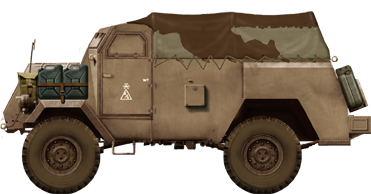 The C15TA Armoured Truck was developed by General Motors Canada to replace the White M3 Scout Car, based on the Chevrolet C15 Canadian Military Pattern (CMP) truck chassis. Between 1943 and 1945 some 3,961 were built in the Oshawa plant in Ontario, with armoured hulls supplied by Hamilton Bridge. It was not meant for reconnaissance unlike the Otter, but rather like an armoured personal carrier, the first designed and built in Canada. It was widely used in Europe in 1944-45, starting in France and Italy, and after the war, saw action with Belgium, Greece, Denmark, the Netherlands, Norway, Spain, France, South Vietnam, South Africa, Malaya, Portugal and Mozambique afterwards, well helped by the commonality of parts from the 400,000 CMP trucks delivered by Canada in WW2.
The C15TA Armoured Truck was developed by General Motors Canada to replace the White M3 Scout Car, based on the Chevrolet C15 Canadian Military Pattern (CMP) truck chassis. Between 1943 and 1945 some 3,961 were built in the Oshawa plant in Ontario, with armoured hulls supplied by Hamilton Bridge. It was not meant for reconnaissance unlike the Otter, but rather like an armoured personal carrier, the first designed and built in Canada. It was widely used in Europe in 1944-45, starting in France and Italy, and after the war, saw action with Belgium, Greece, Denmark, the Netherlands, Norway, Spain, France, South Vietnam, South Africa, Malaya, Portugal and Mozambique afterwards, well helped by the commonality of parts from the 400,000 CMP trucks delivered by Canada in WW2.
Development: The Canadian Military Pattern Trucks
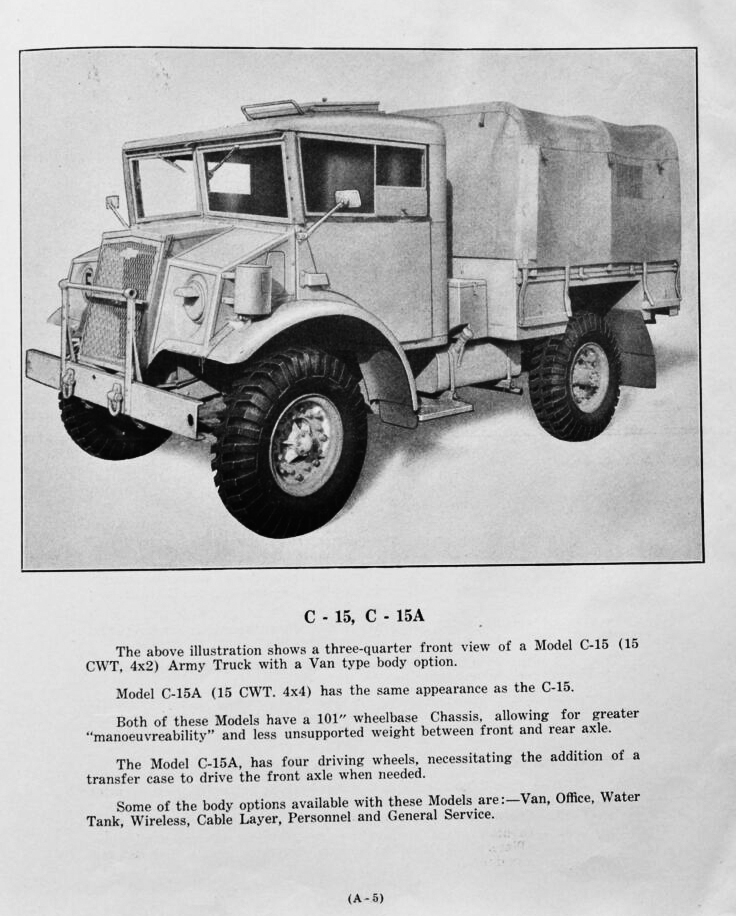
Documentation guard page on the Chevy C15 and C15A
The Canadian Military Pattern (CMP) trucks were military vehicles produced in Canada to an amount of 400,000 vehicles, through several brands during World War II. They were all ported on a common British Army standard already in 1938 trucks and manufacture under license from the British government started in 1939, by Chevrolet, Ford, and Chrysler Canada. The effort was such that truck production of Canada lone out-done Germany, Italy and Japan combined. These trucks were classed into three main categories based on the cwt classification (hundredweight), 15, 30 and 60, with varied whelbases and body types.
But they all shared most parts, including a distinctive "stout nose" and "cab over" engine design, as well as the very same cabin. CMP trucks played a crucial role in the transportation and logistical support of Canadian and Allied forces during the war. They were used for various purposes, including troop transport, cargo transport, artillery towing, and as mobile workshops, and were found in all commonwleath armies. They were also assmbled locally in Britain, Australia, New Zealand, India and South Africa, all designing their own armoured car.
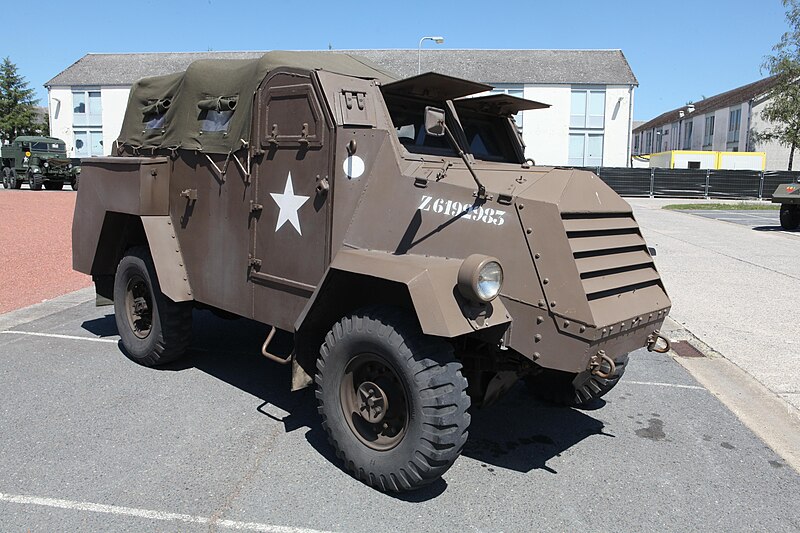
CMP trucks were known for their robustness, reliability, and adaptability, made to withstand the harsh conditions of war, perform in various terrains, and be easy to maintain. No wonder why Canada derived two types of armored car from the base Ford/Chevrolet 15 cwt in its 4x4 form: The Otter and the CT15A APC. The first was the most commmon Canadian reconnaissance armoured car, the second its first armoured personal carrier, with an even larger production and widespread use unlike tanks such as the Grizzly and Ram.
From the Chevy CT15A to an armoured Car
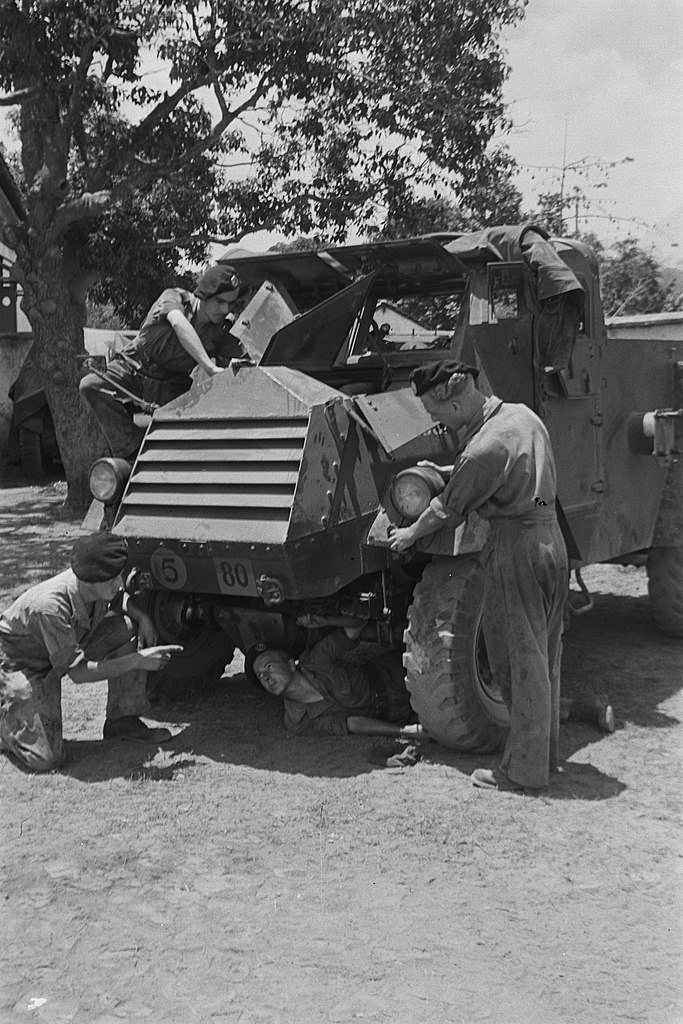
KNIL CT15A being maintained by its crew. Note where the tarpaulin is rolled and stored, close to the arches. Note also the spare wheel is absent, showing its bracket and guard plate in front.
The CT15A Armoured Car was planned to be created as the need started to emerge in 1943 for a replacement for the criticized M3 Scout Car and M3 GHalf Track in service with the Canadian Forces. Bith were seen as underpowered, sluggish and vulnerable, with paper-thin flat armour. The Canadian industry at the time had a solid undustrial basis to start such cgallenge. The Canadian Military Pattern (CMP) Chevrolet cwt 15 (hence the "C" in CT) truck was found an excellent starting point in 1943, with the "A" meaning 4x4.
The designers arranged a an armored body derived from the already produced Otter, but specifically designed for troop transport as faster APC compared to the M3 Half-Track. To gain design time and ease of manufacturing and maintenance, it was decided to share as many components as possible with the Otter armoured car. It featured sloped armor plates offering the same basic body type, providing protection against small arms fire and shell fragments. The nose was basically the same as the Otter, but the rear section was completly new, with an open troop compartment in place of the fighting compartment of the Otter. It had a crew of eight total, two in the cabin, driver and co-driver, often a member of the squad and acting as MG-gunner, whereas six infantrymen were seated in the rear compartment
During World War II, the CT15A was primarily used by the Canadian Army, but some were also supplied to other Allied forces, including the British Army. They were deployed in various theaters of war, including Europe and Italy. The CT15A played a significant role alonsgide the Otter in fast reconnaissance columns. The Otter provided firepower, and the CT15A provided infantry support (see later). To underline its nature, it was called an "armoured load carrier" and in general an "armoured truck", rather than "armoured car" which was given to the Otter despite both vehicle sharing the same basis. This reflected the reconnaissance nature of the latter (always given to "cars") and transport duties of the former.
Design of the CT15A
General Motors of Canada (Chevrolet Canada) C15TA was tasked of converting the four-wheel drive standard 15cwt chassis. It was powered by the US-produced 270ci six-cylinder OHV engine, which performed exceptionally well in its assigned function. In fact as hoped, the vehicle eventually replaced the M5 halftracks and White Scout Cars in Canadian service, for a grand total of 3,961 vehicles.The vehicle was caracterized by a bull snout and slab sides, being 8 feet tall, and shared this aspect wth the Otter armoured car. The C15TA share the 15cwt chassis but it receoved new roadwheels, 10.50 x 16 tyres for additional ground clearance and better footprint. It was good torque, good tractability, and power-to-weight aplenty. Compared to the sluggish M3 Scout Car, this vehicle was exceptionally well receveid by the troops. On its left rear jerrycan stowage was arranged as well as a pintle hook and tools, but without British-style POL containers in favor of a more conventional type. Massive stowage bins were also installed at the rear, covering the rear axle arches and thus doubling as rear fenders. The two brackets on the bottom outside of the body were protectors for tail lights doubling as steps, also thought ot ease manufacturing. But there were not even the most clever bits of the design.
If the cabin was classic, with two seats, the troop compartment was arranged in a particular way, with four seats close to the cabin (no separation), facing outwards. Behind the last two seas were placed at an inwards angle. The whole compartment could be closed by three arches, on which a tarpaulin could be buttoned up. There was a rear armoured door for easy access, which slot carried a set of collapsible wire stowage bins accessible from inside the troop compartment. This same door also hold the removeable footwell plates.
Side view of a brown CT15
Rear view, with the rear door. Note the arches stored close to the cabin.
Forward view. Similarities with the Otter are obvious.
Rear Compartment. Note like the cabin is very close to the rear compartment. The armoured walls are just enough for the men to see outside if needed and duck.
Driver's position, wheel and simle dashboard with all essential gages.
Cabin interior, drive and co-driver's positions, and access hatch to the transmission.
Top view, to see the rear compartment and internal bins, the open light armoured roof.
The side armour around the troop compartment extended to the tarpaulin to save weight for the basic vehile, although the ambulance version was produced with the latter extending to the top. It seems that if the war has later longer, the normal evolution of the type would have been to comprised a fully armoured roof, all six seats facing outwards to pistol ports. This could have been a really interesting early 4x4 APC, granddaddy of modern 8x8 "a la pirhana" APCs familiar to modern battlefields.
The Crew Compartment forward comprised the driver's station, with basic Instrumentation and controls directly taken from the standard cwt truck. The engine cover was particular, haxagonal, sloped, and with a radiator grille identical to the Otter. Both the driver and co-driver had their own side access door, and were protected by a thin armoured roof. All vehicles has a stretcher mounted on detachable brackets. Te co-driver's station was also equipped like the driver with an armoured windshield cover, using a crude but trusted latch mechanism. Visibility in closed mode was, as usual, mediocre and only used in intense fighting. It was opened (as the same door shutters) in normal use. There were a 'pistol' ports on these, seldom used but as fresh air vents.
Still clsoe to the co-driver's station there was a bin in the door with glass windscreens and the upper section for both side doors opened down and out. The co-driver's door could not be latched open as the other sine a spare tyre was placed there. Also close to the co-driver's station was installed a collapsible wire bin like the one stowed in the rear door. robably used to store personal kit. Important were the rifle clips at the forefront, since the vehicle was essentially unarmed. At the rear close to the inwards-facing rear seats was installed a removeable floor plate open up to reveal footwells, and enable the crew to leave of the vehicle toppled over or was stranded under heavy fire, preclusing the use of the rear door. In the original design, the two folding rear troop seats were bolted to the checkerplate, but perpendicular to the diagonal edges of the footwell. This was changed for production.
The troop compartment also comprised multiple rifle clips. The side-by-side troop seats facing outward were not folding as the rear ones. This only six mean could ne seated at all time, but these were easy to remove to cram more troops inside, up to ten and more given some accounts. The lack of armament was not a problem apparently, restricting the role of the vehicle as a "battle taxi" and northing else, since organically, the Otters were to provide support fire. There was still the possibility of removing the co-driver window and fit a Bren-Gun mount, but it was never seen.
The CT15A in action
The C15TA was produced in 1944-45 and so it missed, unlike the Otter, the compaign of North Africa, and was started to be available from the time of the Italian campaign started. However production ramping up allowed it to be depliyed virtually all other Canadian vehicles in Northwest Europe, from D-Day onwards. It worked both as armoured personnel carrier under its CT-15A and as ambulance (CT15AA). There were few known variants apart these. They were in numbers at the time of the Netherlands liberation from October 1944 and it soldiered on until the end of the compaign with the British Army in northern Germany. They took part in the battle of de Scheldt Estuary and Rotterdam. The vehicle was used an APC but it's generous torque made it also a useful grun tractor when used as such, for example towing the standard 25-pdr howitzer. This came handy as it carried also the gun crew in a more protected way compared to a standard tractor.But their fate after the war is as much as interesting if not more. The CT-15A saw decades of combat service under other flags. It was distributed to Denmark (Formerly "M6 Otter" because of its familiarity with the Otter but later renamed "M6 Mosegris" and used as APC and communications vehicle for a good decade) and the Netherlands (circa 396 units), Belgium, Greece, Denmark, and Norway. 150 were sold to Spain also, where it was called "Trumphy". They served with the Cavalry Regiment nº 10 Alcántara others at Ceuta and Melilla, plus Light Cavalry Group Saharianos (Spanish Legion). No modifications but a cal.50 HMG and a new camouflage.
Those of British forces deployed in Vietnam were left there and taken over by the French when they came back. So the vehicle was widely used in Indochina (1945-1954) and later transferred to South Vietnam, and used bot by the VNA and ARVN until the fall of Saigon in 1973. A command variant was exported to the South Africa also. Other were found in police forces of the Federation of Malaya, also left over British vehicles, soldiering with the Dingo Scout Car. In fact between 1948 and 60, the Royal Malaysian Police used dark blue painted C15TAs in quantities for all sorts of missions as the 'JMC'. They often had extended armor as the French Models. It seems also that some were passed onto Australia, which took part in the Korean War. Photos showed the 3rd Battalion, Royal Australian Regiment using some.
British vehicles left in the middle east also saw service for some time, mostly in Palestine. Just as CMP C15/F15 were transformed into armored cars, Israel used fully covered, better armed variants, notably with eight sided machine gun turrets installed, and had some transferred to Egypt. In 1955, Portugal received some, renamed GM 4x4 m/947 Granadeiro (Grenadier) and used extensively in its African wars until the late 1960s, as for the Netherlands when deployed in the Dutch East Indies. In the end, the ones left by the latter when they left what became Indonesia, were taken over in turn by Indonesian forces. It seems the latter still maintained them active (circa 129 in 1959 plus four command versions) until 1961.
Some survived much longer... In 1989 half a dozen remaining hulls were still rotting in a training base at Amersfoort. The few in good enough condition were recuperated by individuals and associations for restoration. Thanks to their effort there ate today at least three fully working vehicles used in parades and reenacments.
CT15A specifications | |
| Dimensions | 4.75 x 2.34 x 2.31 m (15 ft 7 in x 7 ft 8 in x 7 ft 7 in) |
| Total weight, battle ready | 4.5 t |
| Crew | 2+6, see notes |
| Propulsion | GMC 6 cyl. gasoline 100 hp (74 kW) p/w 22.2 hp/tonne |
| Maximum speed | 65 km/h (40 mph) |
| Transmission | As Chevy C15 |
| Suspension | 4 x 4 wheel, leaf spring |
| Range | Circa 500 km (320 miles) |
| Armament | Bren Gun, personal weapons. |
| Armor | 6-14 mm |
| Total production | 3,961 |
Links
I. Moschanskiy - Armored vehicles of the Great Britain 1939-1945 part 2, Modelist-Konstruktor, Bronekollektsiya 1999-02Roger V.Lucy, "The C15TA in Canadian Service", Service Publications,Ottawa, 2012
List of surviving C15TA trucks
Danish Mosegris
mapleleafup.net
wikipedia.org
Gallery
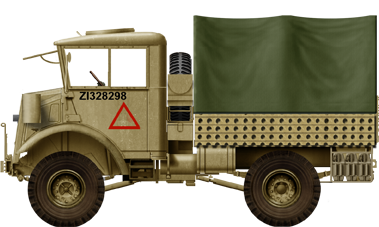
Ford C15 CMP for comparison
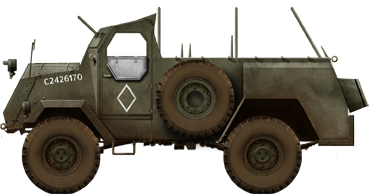
Vehicle of the 10th Armoured Regiment, 2nd Canadian Brigade, France Normandy July 1944
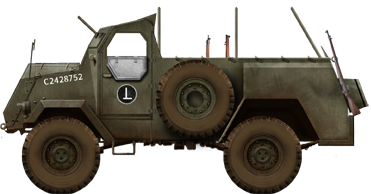
Vehicle of the 1st Canadian Armoured Car Rgt., Royal Hamilton Light Infantry, 4th Can. Inf. Brigade, 2nd Canadian Infantry Brigaden 2ns Canadian Infantry Division, 2nd Canadian Corps, 1st Canadian Army Holland 27 October 1944
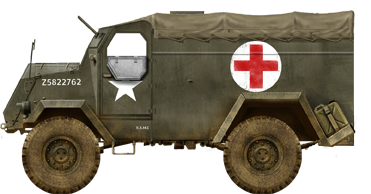
Ambulance version, Normandy France 1944
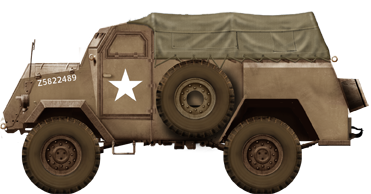
Vehicle of the CIABG Enginee Company 4, 1945

"Aristocrat", 5th Canadian Armoured Division, Belgium 1945
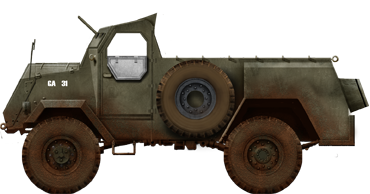
Dutch CT15A with the KNIL, 1950
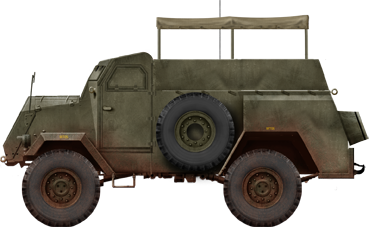
Modified vehicle of the Vietnamese National Army (VNA)
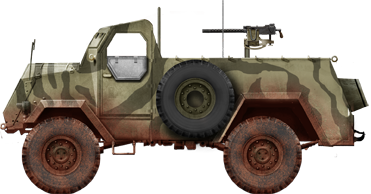
Vehicle of the ARVN in the late 1960s
Czech CT-15
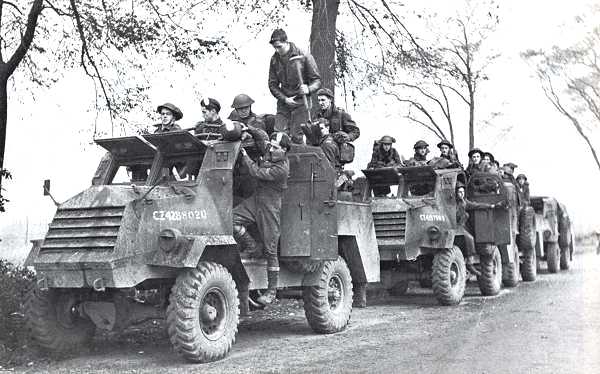
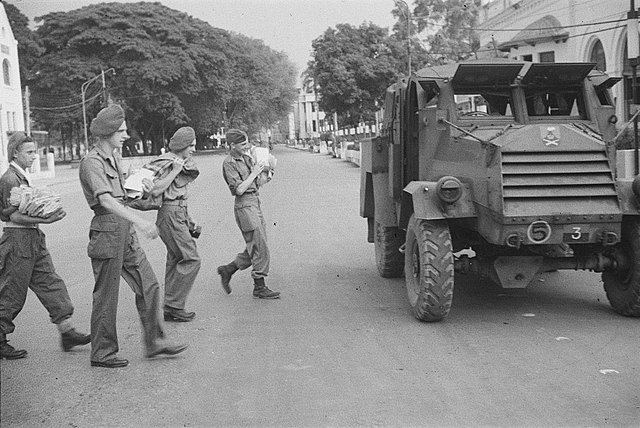
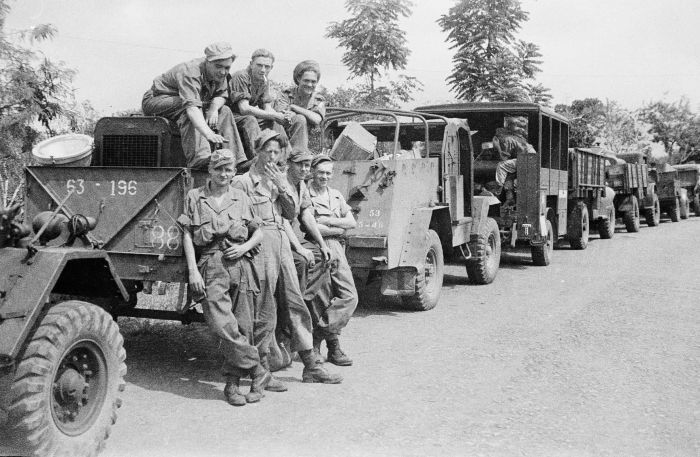
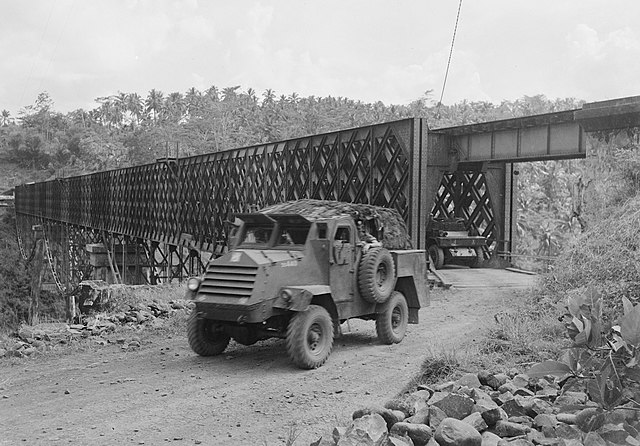
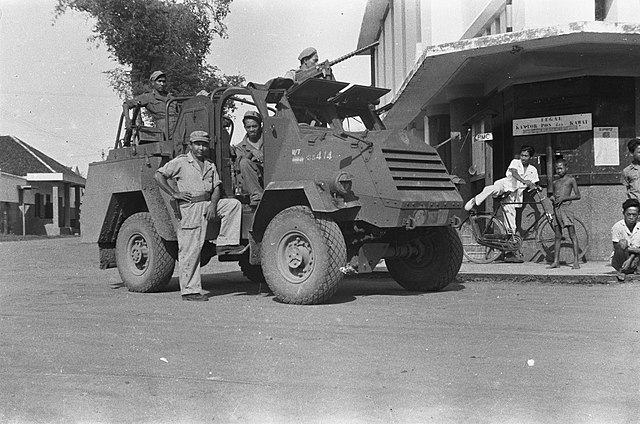
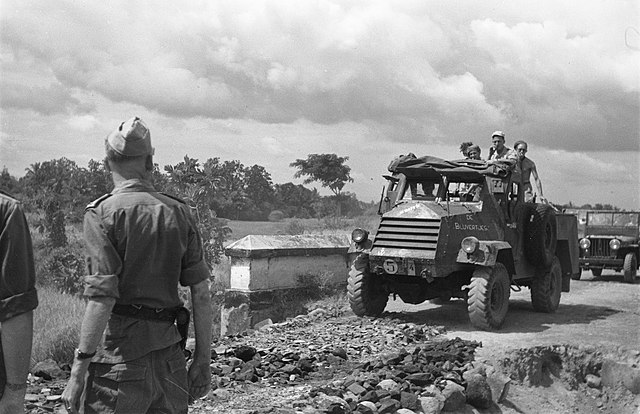
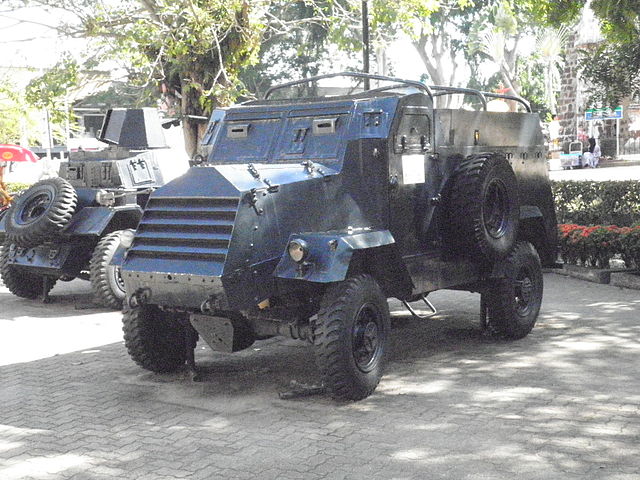
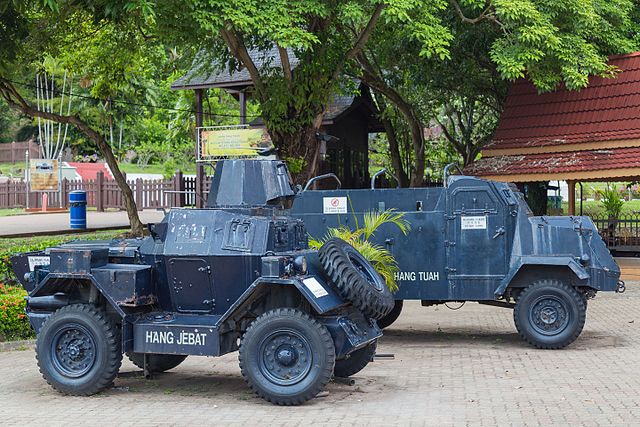
Malayan Vehicle, in Police dark blue livery

WW2 Tanks




























WW2 tanks posters

All Tiger tanks liveries.

Panther liveries and variants

WW2 Armour - All tanks











Tanks aces and single tanks series

Find more there

Museums, Movies, Books & Games
The Tanks and Armor in pop culture
Tanks and armored vehicles in general are only really grasped when seen first person: The mass, the scale, it's all there. Explore also the way tanks were covered in the movie industry, in books and in video games.Movies:
Best tanks movie on warhistoryonline.com
On imdb.com
On bestsimilar.com/
miltours.com
liveabout.com/
watchmojo.com
Video Games:
pcgamesn.com
historyhit.com
levvvel.com
vg247.com/best-tank-games
mmobomb.com/
alienwarearena.com

